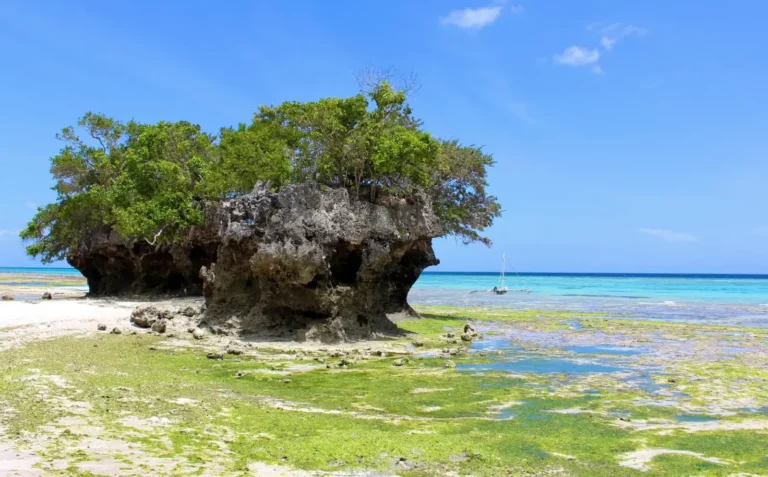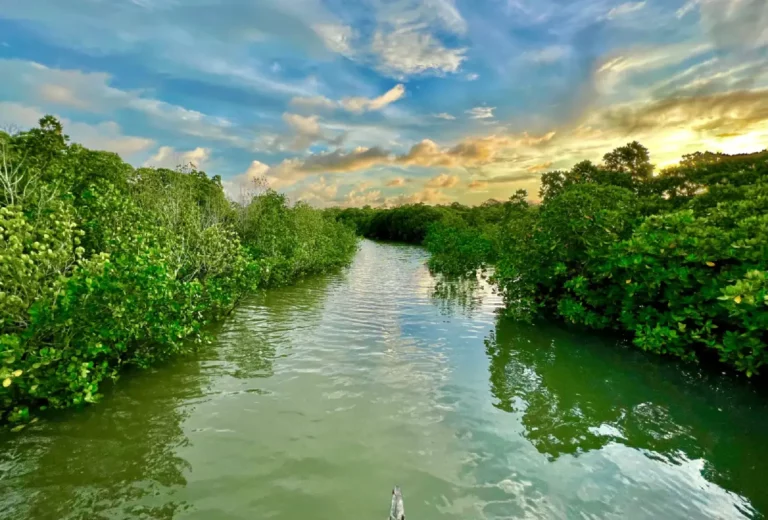Zanzibar by Dhow: Sailing Traditions and Sunset Cruises
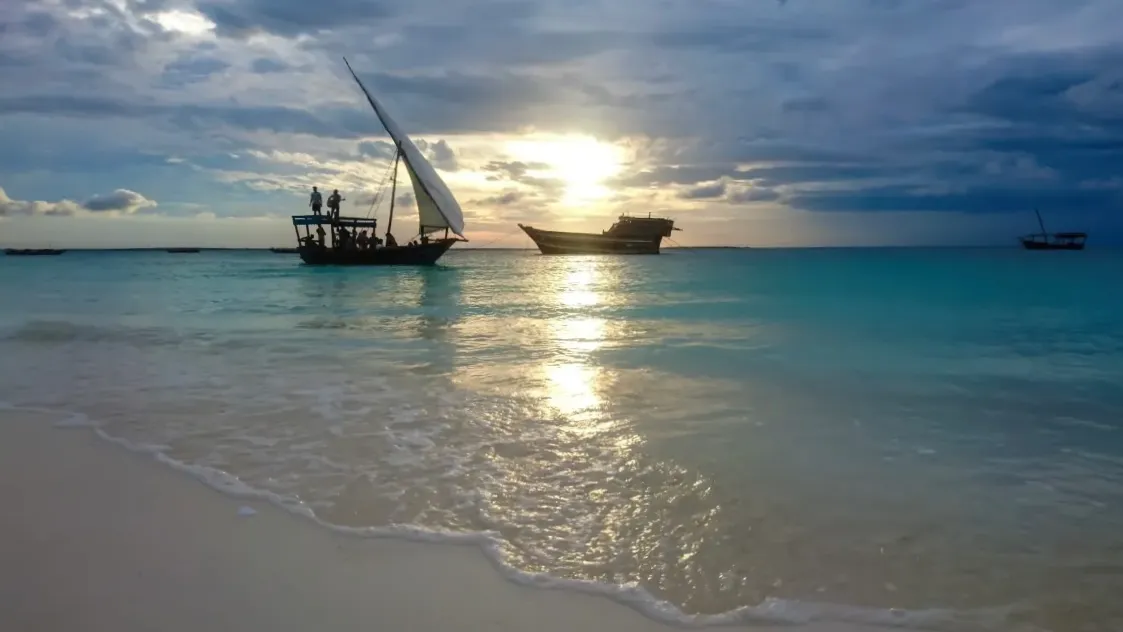
Somewhere off the coast of Stone Town, the ocean glows like molten gold. A triangular white sail catches the last kiss of sun, cutting through the glassy surface with unhurried grace. There’s no roar of engines, no glaring lights. Just the creak of polished wood, the soft flap of canvas in the wind, and the salt-kissed rhythm of the sea. It’s quiet in a way that feels sacred—like the sea is holding its breath. This isn’t a fantasy—this is a dhow cruise in Zanzibar, and it’s as close to magic as you can sail without leaving Earth.
For centuries, these elegant wooden boats have danced along the Swahili Coast, connecting Zanzibar to the Arabian Peninsula, India, and beyond. Their sails once caught the monsoon winds that carried spices, silk, and stories across oceans. Today, they offer travelers more than just a ride—they offer a portal to a timeless Zanzibar. Whether you’re sipping chilled tamarind juice on a sunset sail or snorkeling off a hand-carved deck near Mnemba Atoll, stepping aboard a dhow is an invitation to slow down and dream with your eyes open.
Table of Contents
What Is a Dhow? A Sail Shaped by History

Long before speedboats zipped through Zanzibar’s turquoise lagoons, the dhow reigned supreme. Traditionally rigged with one or more lateen (triangular) sails and a narrow, elegant hull, dhows are masterpieces of both form and function. They are built for long-distance travel, wind-powered grace, and a deep understanding of the sea.
Their origins trace back to the Arabian Peninsula, where they were crafted for fishing, trade, and transport. As early as the 7th century, they were plying the waters between Oman, Yemen, and the East African coast, carrying dates, frankincense, ivory, gold, and enslaved people across the monsoon-swept ocean. Zanzibar, as a hub of the Indian Ocean trade, became a natural harbor for these vessels. They brought wealth and sorrow, spice and song, faith and fashion.
Over time, the dhow became woven into the very soul of Swahili culture—its silhouette etched into stories, songs, and ceremonies. Even today, you’ll find it proudly displayed on Zanzibar’s official coat of arms.
Zanzibar’s Maritime Past: Echoes in the Tides
To sail on a dhow is to float through layers of Zanzibar’s past. These waters have witnessed sultans and slavers, explorers and merchants, pirates and poets. From the Omani-controlled spice trade to Portuguese colonial skirmishes and British abolitionist patrols, the dhow was there through it all—silent, steadfast, salt-stained.
In the golden age of Swahili city-states, dhows weren’t just tools of commerce—they were symbols of prestige and skill. Captains were respected navigators who read the stars and the wind like scripture. Shipbuilders were artisans, their craft passed from father to son with whispered reverence. In Nungwi and Kendwa, this tradition still survives—though increasingly endangered by fiberglass boats and imported parts.
Yet even as modern tourism reshapes Zanzibar’s shores, the dhow has refused to be left behind. Instead, it has reinvented itself—not as a relic, but as a soulful experience.
Today’s Dhow Experiences in Zanzibar
The modern dhow ride is less about cargo and more about wonder. You don’t need to know how to tie a reef knot or decipher the monsoon calendar. You just need to sit back, breathe in the salt air, and let the island reveal itself from the sea.
Sunset Cruises
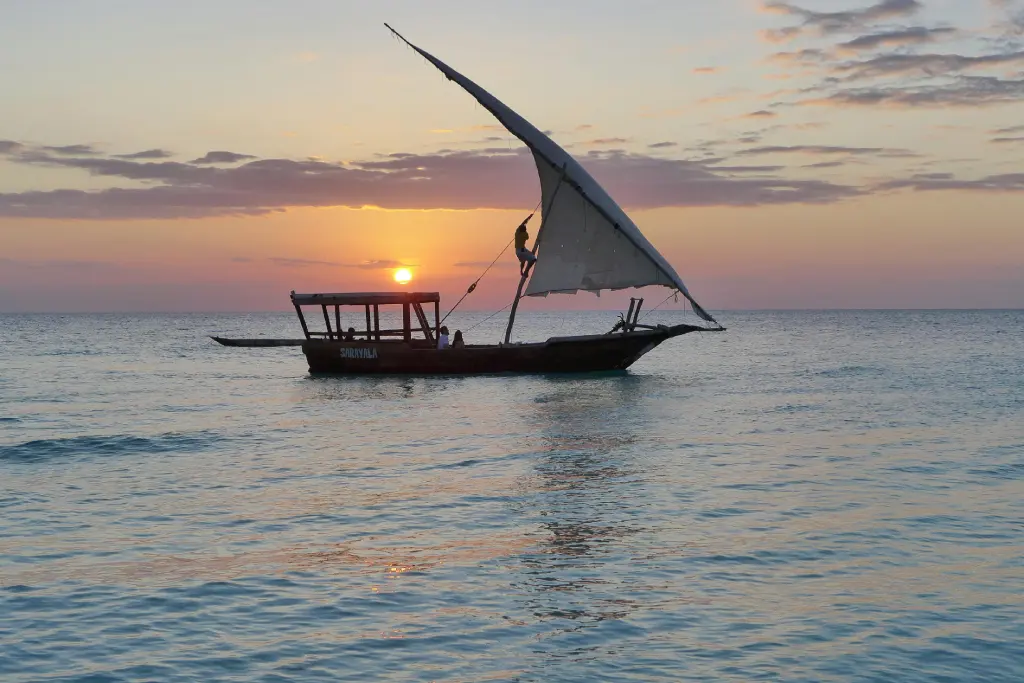
This is the classic Zanzibar dhow experience: a late-afternoon departure, drifting out from Stone Town, Nungwi, or Michamvi, with chilled drinks in hand and golden light bathing the sails. As the sun sinks into the Indian Ocean, casting flaming trails across the water, many boats serve light Swahili snacks—think grilled octopus, samosas, coconut crisps—and play soft taarab music. Some even feature live drumming or a local guide reciting tales of Zanzibar’s past.
Couples book them for romantic evenings, but they’re just as enchanting for solo travelers or families. The silence at sea is communal, introspective, and deeply healing.
Snorkeling Adventures
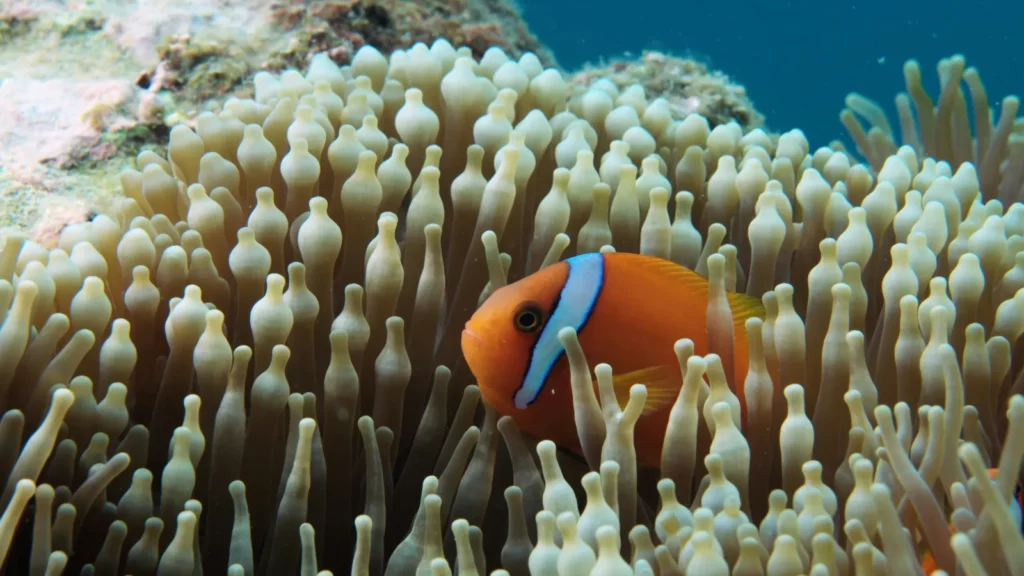
For a splashier twist, dhows also take visitors to Zanzibar’s best marine sanctuaries. Mnemba Atoll is the star—its coral gardens are home to parrotfish, trumpetfish, octopuses, and sometimes dolphins. Glassy waters make visibility ideal, especially from January to March. Dhow crews often provide masks and fins, though bringing your own ensures a better fit.
Some excursions stop for beach picnics on nearby sandbanks or offer seafood barbecues on deck—a grilled barracuda filet under the sun, with the scent of lime and sea breeze all around.
Private Charters & Celebrations
For honeymooners or those marking a special occasion, private dhow charters add a luxurious touch. You can sail past mangrove-fringed coasts, pop champagne on a secluded bay, or dine by lantern light under the stars. High-end operators often include gourmet meals, custom itineraries, and professional photographers.
Others choose dhows for intimate weddings, proposal setups, or milestone birthdays. The combination of old-world beauty and island atmosphere creates a setting that no venue on land can rival.
Where to Set Sail: Zanzibar’s Best Dhow Destinations
Zanzibar’s coastline is rich and varied—every cove tells a slightly different story, and every dhow ride offers its own brand of magic. While these traditional vessels can be spotted all around the archipelago, certain places lend themselves more naturally to the art of sailing.
Stone Town: Where History Meets Horizon

Stone Town, Zanzibar’s UNESCO-listed old quarter, is a natural launching point for dhow cruises. Here, history clings to every coral rag wall and carved wooden door. But out at sea, the view shifts: instead of looking up at history, you float alongside it.
As you drift away from the harbor, the skyline of minarets and crumbling Portuguese fortifications grows small in the distance. The breeze carries the faint scent of cloves and charcoal. You pass fishermen casting nets, young boys doing backflips from the pier, and other dhows returning home with the day’s catch. Sunset cruises here are particularly photogenic, with the sun setting behind the House of Wonders or the Beit al-Ajaib.
If you’re lucky, you may sail on a restored historical dhow—some over a hundred years old, their sails patched with care, their decks polished with age.
Nungwi and Kendwa: The Heartbeat of Dhow Craftsmanship
On Zanzibar’s northern tip, the villages of Nungwi and Kendwa are not only known for wide beaches and vibrant nightlife—they’re the island’s dhow-building heartland. Here, you’ll see these vessels in their skeletal state, propped on logs along the shoreline like resting sea dragons.
Taking a dhow ride from this region is special. There’s an intimacy in boarding a boat built just meters from the sand, often by the same family that now captains it. Sunset sails here are less urban, more elemental. The horizon feels bigger. The colors are bolder. And the sails, catching the golden light, seem to glow from within.
Michamvi and Chwaka Bay: Off the Beaten Wake
If you prefer silence and solitude, head east to Michamvi Peninsula or the still waters of Chwaka Bay. These less-touristed areas offer dhow rides through mangrove forests and mirror-flat lagoons. The mood is meditative. The wildlife—herons, kingfishers, maybe a shy monkey in the trees—more pronounced.
These cruises often include opportunities to swim in hidden tidal pools or visit isolated villages where the dhow is still king.
Mnemba Atoll: Snorkel, Sail, and Swim
For marine life, nothing beats a dhow trip to Mnemba Atoll. Though technically a marine conservation area off the northeast coast, the journey itself is half the joy. Setting sail from Matemwe, your dhow cuts through brilliant blue waters toward a ring of coral that’s home to hundreds of species—reef fish, turtles, dolphins, and even the occasional whale shark in season.
Snorkeling from a dhow is a different experience from a speedboat—you approach slowly, respectfully. The boat anchors at a gentle distance. You climb down a wooden ladder into a living underwater world, knowing the same boat will be there waiting, steady and timeless, when you resurface.
The Art of the Dhow: Craftsmanship by the Sea
In a shaded yard in Nungwi, the scent of sawdust mingles with salt air. A group of men work with quiet focus—no machines, just hand tools and knowledge passed through bloodlines. This is where dhows are born.
A Tradition Carved in Wood
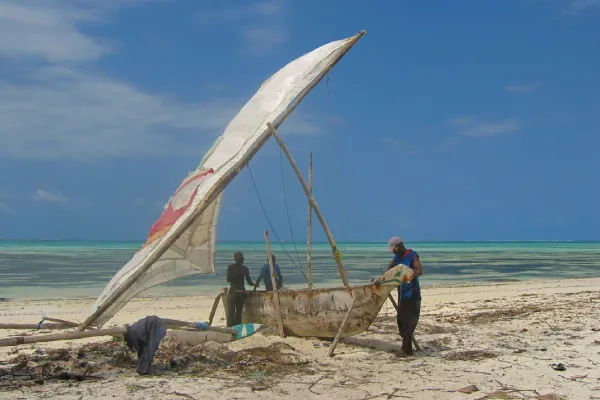
The process is slow, methodical. Planks of mangrove or mvule are shaped and fastened into ribs with hand-forged nails. No blueprints. No CAD files. Just chalk lines and muscle memory. The wood is cured with fish oil or tar, then fitted with handmade sails stitched from cotton or canvas.
It’s a marvel to witness. These men are not just boatbuilders—they are preservationists of an ancient craft, working against time and tourism trends. Many fear that once the older builders retire, this art will disappear.
Stories from the Yard
Some boats take months to finish. Others—especially smaller ngalawas (outrigger canoes)—are completed in weeks. Many dhow builders tell stories as they work: about storms weathered, ports visited, or boats named after lost loves.
Tourists who take the time to visit these yards often leave with more than photos. They leave with reverence—for the patience, skill, and soul it takes to shape a vessel from tree to tide.
How to Choose the Right Dhow Experience
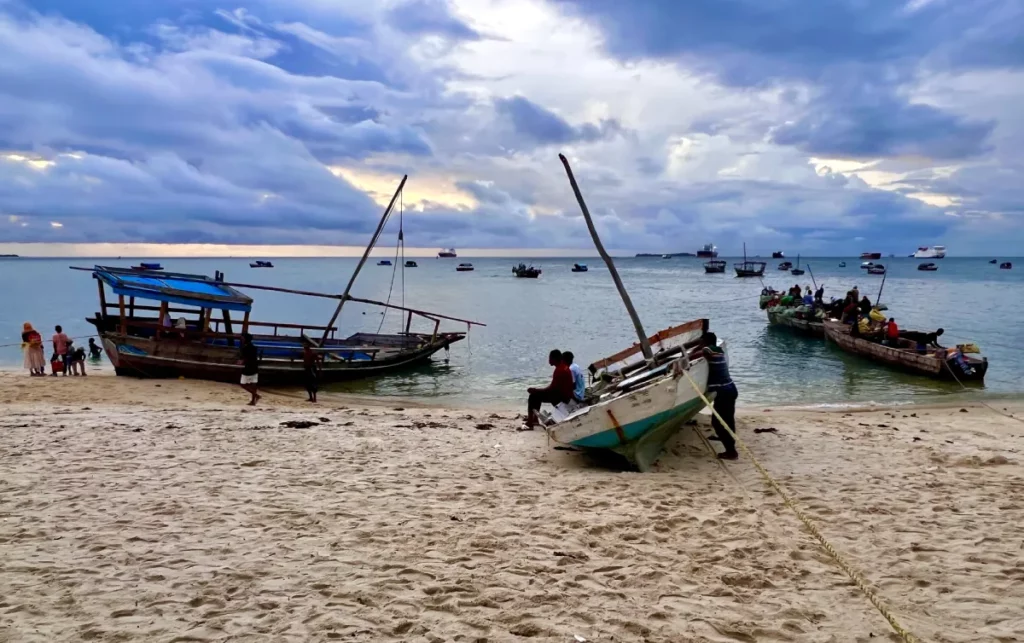
Not all dhow cruises are created equal. Some are deeply authentic. Others are little more than floating bars with loudspeakers and generic itineraries. Knowing what kind of experience you’re looking for—and what to look out for—can make all the difference.
Types of Tours
- Group Sunset Cruises: Affordable and sociable. Typically $15–$30 per person, with snacks and drinks included.
- Half-Day Snorkeling Trips: Often $50–$100. Includes equipment, guide, and sometimes a light lunch.
- Private Charters: Custom experiences ranging from $150 to $500 depending on length, food, and group size.
- Specialty Cruises: Think yoga-at-sea, stargazing, Swahili poetry readings, or dinner with live taarab music.
What to Ask Before You Book
- Is the dhow locally built and owned?
- Are life jackets and safety gear provided?
- Is the crew experienced and certified?
- Is food prepared fresh and hygienically?
- Does the company practice eco-friendly operations (no littering, sustainable snorkeling practices, etc.)?
Selecting the Right Operator
Responsible Tourism: Sailing with Purpose
There’s something sacred about stepping onto a dhow. It’s not just a boat—it’s a vessel of memory, heritage, and craftsmanship. And when we choose to sail it as tourists, we’re stepping into that legacy. That’s why responsible dhow tourism matters.
Support Local Builders and Captains
Many dhow cruises are now operated by large tour companies—efficient but often removed from the cultural roots. When possible, book with local, community-based operators. Look for captains who learned to sail from their fathers, whose boats were carved just down the shore.
Choosing a local dhow operator isn’t just more authentic—it ensures that your money supports coastal families, sustains traditional boatbuilding, and empowers a deeply rooted maritime community.
Sail Light, Leave No Trace
While the dhow itself is eco-friendly (wind-powered and quiet), the experience can still leave a footprint. Opt for operators who avoid littering, provide reusable or biodegradable cutlery, and educate guests about reef protection.
If you go snorkeling, never touch the coral. Avoid sunscreen with oxybenzone and octinoxate, which damage marine ecosystems. Some operators provide reef-safe options—bonus points for those.
When food is served on board, ask where it comes from. Sustainable fishing practices make a difference in preserving the bounty of the Indian Ocean for generations to come.
Practical Tips for an Unforgettable Dhow Experience
Best Time to Go
Dry Season: The Ideal Time to Sail
The dry season in Zanzibar, spanning from June to October and again from December to February, is the best time for a dhow cruise. These months bring clear skies, calm seas, and gentle winds that fill the triangular sails just right. The sunsets are especially breathtaking during this time—rich golds, fiery oranges, and soft purples melting into the horizon as your dhow glides silently across the water. It’s the perfect season for smooth sailing, snorkelling, and those dreamy, camera-ready moments that define a Zanzibar escape.
Rainy Season: Romantic, But Risky
From March to May, the long rains arrive in bursts—sometimes soft and misty, other times sudden and torrential. While the island becomes lush and green during this season, sea conditions can be choppy and visibility poor. Dhow tours often scale back during these months due to safety concerns and reduced demand. Unless you’re chasing dramatic clouds and don’t mind getting soaked mid-cruise, it’s best to plan your sailing adventure for the dry months when the ocean plays nice and the wind tells stories, not warnings.
What to Bring
- Light jacket or shawl for sunset chill.
- Sunscreen (reef-safe, please).
- Sunglasses and a wide-brim hat.
- Swimsuit, towel, and flip-flops for snorkeling tours.
- Waterproof phone pouch or dry bag.
- Camera (but don’t forget to look away from the lens and just feel the moment).
Health & Safety
- Confirm the operator has life vests—especially if you’re not a confident swimmer.
- Let someone know your itinerary if you’re going on a longer cruise or private charter.
- If prone to motion sickness, consider taking anti-nausea meds in advance.
Final Thoughts: The Soul of Zanzibar Floats on the Wind
A dhow is more than wood, sail, and string. It’s the living echo of the island’s past, the graceful bearer of its traditions, and—if you’re lucky enough to step aboard—your personal key to unlocking Zanzibar’s soul.
Out on the water, under sails once guided by stars and salt-worn instinct, time bends. The island looks different from out there. Slower. Older. More honest. The calls of the market and the chaos of modern life fade behind you, replaced by the sound of your own heartbeat syncing with the tide.
If you do only one thing in Zanzibar, let it be this. Board a dhow. Sail into the sunset. And let the island show you not just where it’s going—but where it’s been.
Ready to Set Sail?
Whether you’re planning a romantic escape, a solo adventure, or a cultural deep dive, dhow cruises offer an unforgettable window into the heart of Zanzibar. These journeys aren’t just about movement—they’re about meaning. Each cruise is a moment suspended between sea and sky, where time slows and beauty deepens. Look for authentic, ethical operators who honor the tradition behind the sails and the stories carried on the wind. Bring your sense of wonder, your curiosity, and your willingness to be moved by silence.
And don’t forget—sometimes the best views of paradise come not from a lookout or a rooftop, but from the open sea, with a sail in the sky and the wind in your face.
Karibu Zanzibar. The ocean is calling. Let it carry you somewhere timeless.


